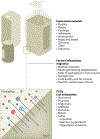Health impacts of exposure to synthetic chemicals in food
- PMID: 40379996
- PMCID: PMC12442484
- DOI: 10.1038/s41591-025-03697-5
Health impacts of exposure to synthetic chemicals in food
Abstract
Humans are widely exposed to synthetic chemicals, especially via food. The types of chemical contaminants in food (including food contact chemicals) are diverse, and many of these are known to be hazardous, with mounting evidence that some contribute to noncommunicable diseases. The increasing consumption of ultra-processed foods, which contain synthetic chemicals, also contributes to adverse health. If the chemical contamination of foods were better characterized, then this issue would likely receive more attention as an important opportunity for disease prevention. In this Review, we discuss types and sources of synthetic food contaminants, focusing on food contact chemicals and their presence in ultra-processed foods. We outline future research needs and highlight possible responses at different food system levels. A sustainable transition of the food system must address the health impacts of synthetic chemicals in food; we discuss existing solutions that do justice to the complexity of the issue while avoiding regrettable substitutions and rebound effects.
© 2025. Springer Nature America, Inc.
Conflict of interest statement
Competing interests: The authors declare no competing interests.
Figures




References
-
- Tickner J, Geiser K & Baima S Transitioning the chemical industry: the case for addressing the climate, toxics, and plastics crises. Environ. Sci. Policy Sustain. Dev 63, 4–15 (2021).
-
- Freinkel S Plastic: a Toxic Love Story (Houghton Mifflin Harcourt, 2011).
-
- Smith C, Hill AK & Torrente-Murciano L Current and future role of Haber–Bosch ammonia in a carbon-free energy landscape. Energy Environ. Sci 13, 331–344 (2020).
Publication types
MeSH terms
Grants and funding
- R01ES032214/U.S. Department of Health & Human Services | National Institutes of Health (NIH)
- R01ES029779/U.S. Department of Health & Human Services | National Institutes of Health (NIH)
- P2CES033423/U.S. Department of Health & Human Services | National Institutes of Health (NIH)
- UH3 OD023305/OD/NIH HHS/United States
- R01 ES029779/ES/NIEHS NIH HHS/United States
- R01 ES032214/ES/NIEHS NIH HHS/United States
- UG3OD023305/U.S. Department of Health & Human Services | National Institutes of Health (NIH)
- UG3 OD023305/OD/NIH HHS/United States
- 2030 ANR-24-RRII-0005/Agence Nationale de la Recherche (French National Research Agency)
- P2C ES033423/ES/NIEHS NIH HHS/United States
LinkOut - more resources
Full Text Sources
Medical

